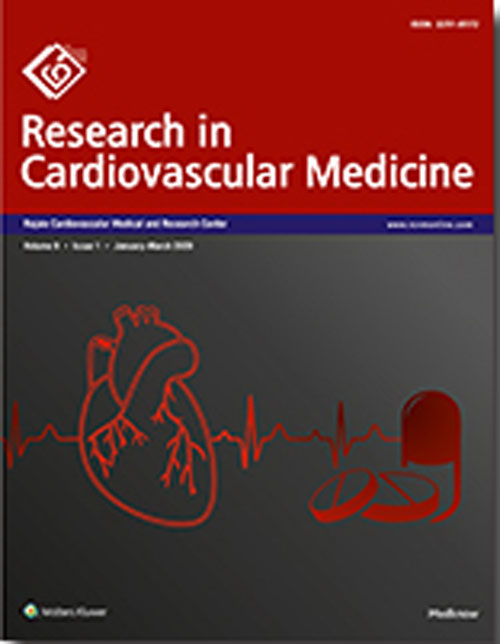فهرست مطالب

Research in Cardiovascular Medicine
Volume:9 Issue: 30, Jan-Mar 2020
- تاریخ انتشار: 1399/03/01
- تعداد عناوین: 6
-
-
Pages 6-9Objectives
The purpose of this study was to assess the association between a prolonged PR interval and significant coronary artery disease (CAD) in patients who were acutely admitted with unstable angina or non‑ST‑segment elevation myocardial infarction (NSTEMI).
BackgroundProlongation of the electrocardiographic PR interval occurs frequently in clinical practice. Few studies to date have evaluated the association between prolonged PR intervals and significant CAD in hospitalized patients with NSTEMI and unstable angina.
MethodologyPR interval was measured in 205 patients with NSTEMI or unstable angina, and the patients were divided into those with normal (<200 ms) and prolonged PR interval (≥200 ms). We performed echocardiography and coronary angiography within 48–72 h after hospitalization in all patients.
ResultsA prolonged PR interval (>200 ms) was present in 96 patients (46.8%). This finding was statistically significantly associated with significant CAD (P = 0.024). In addition, these patients had a trend toward higher Gensini scores (P = 0.093) and a higher frequency of left main coronary artery or three-vessel CAD (P = 0.069).
ConclusionOur study showed that a prolonged PR interval is independently associated with significant CAD in patients with acute coronary syndrome, in contrast with earlier beliefs.
Keywords: Acute coronary syndrome, electrocardiography, first‑degree atrioventricular block, myocardial infarction, PR interval -
Pages 10-15Aims
Exercise training is one of the nonpharmacological treatments for heart diseases. The aim of this study was to investigate the effect of 8‑week endurance rehabilitation training on apoptosis among cardiac patients. Subjects and
MethodsSixteen postcoronary artery bypass grafting patients, having examined by specialists, were randomly assigned to control (n = 8) and experimental groups(n = 8). The experimental group completed a training protocol including running on a treadmill at 55%–70% of their maximum heart rate for 8 weeks. Blood sampling was performed after 12–14 h of fasting and before and after the 8‑weeks training to measure biochemical variables. The measurement of Bax and B‑cell lymphoma‑2 (Bcl‑2) was conducted using the ELISA kit. The data analysis was carried out using the independent sample t-test at P ≤ 0.05.
ResultsThe results showed a significant difference between the participants’ mean Bax (P = 0.011) and Bcl-2 (P = 0.015) values after the intervention for both the groups. Likewise, the difference between the ratios of Bcl‑2/Bax values after the intervention was significant for both the groups (P = 0.023).
ConclusionsAccording to the findings of the study, it seems that the endurance rehabilitation training exercises could have a protective effect against apoptosis.
Keywords: Apoptosis, cardiac patients, rehabilitation exercises -
Pages 16-22Background
The purpose of this study was to investigate the effects of combined rehabilitation and yoga training on salivary levels of alpha-amylase and cortisol in patients after coronary artery bypass graft (CABG).
MethodsIn this quasi-experimental study, 20 CABG patients were randomly divided into two groups of cardiac rehabilitation training group (CRT, n = 10) and combined training group (yoga-cardiac rehabilitation) (computed tomography [CT], n = 10). After initial clinical evaluation, exercise test, and salivation with 12 h fasting, individuals were referred to the rehabilitation ward of Shahid Rajaie Heart Hospital in Tehran and performed their exercise program for 8 weeks and three sessions per week then their evaluations were made again. A dependent t‑test was used for intra‑group changes and an independent t‑test was used to compare the two groups at a significant level of 0.05.
ResultsThe CT group showed a significant effect on salivary cortisol (P = 0.028), but these interventions did not show a significant effect on salivary alpha‑amylase (P = 0.193). Furthermore, CRT alone had a significant effect on salivary cortisol indices (P = 0.011), there was no significant difference between groups (P ≤ 0.05).
ConclusionThe results showed that combined yoga and rehabilitation training had beneficial effects on the salivary levels of the stress factors that have been studied. Therefore, this type of rehabilitation exercise is recommended for secondary prevention of cardiovascular disease.
Keywords: Cardiac rehabilitation, cardiovascular disease, salivary alpha-amylase, salivary cortisol, yoga -
Pages 23-27Aim
One of the most crucial and common occupational hazards in different industries is physical fatigue. Fatigue plays a vast role in all industries in terms of health, safety, and productivity and is continually ranked among the top‑five health‑related risk factors year after year. The current study focuses on a novel method to detect workers’ physical fatigue employing heart rate signals.
Materials and MethodsFirst, domain features are extracted from the heart signals utilizing different entropies and statistical tests. Then, K‑nearest neighbors algorithm is used to detect the physical fatigue. The experimental results reveal that the proposed method has a good performance to recognize the physical fatigue.
ResultsThe achieved measures of accuracy, sensitivity, and specificity rates are 78.18%, 60.96%, and 82.15%, respectively, discretely for fatigue detection.
DiscussionBased on the achieved results, it is conceived that monitoring of heart rate signals is an effective tool to assess the physical fatigue in manufacturing and construction sites since there is a direct relationship between fatigue and heart rate features. The results presented in this article showed that the proposed method would work well as an effective tool for accurate and real‑time monitoring of physical fatigue and help to increase workers’ safety and minimize accidents.
ConclusionThe results presented in this article shows that the proposed method would work well as an effective tool for accurate and real‑time monitoring of physical fatigue and helps to increase workers’ safety and minimize accidents.
Keywords: Entropy, hear rate, physical fatigue

